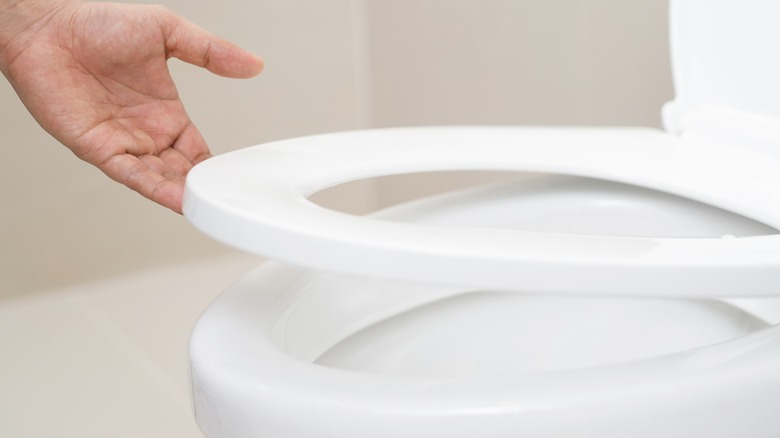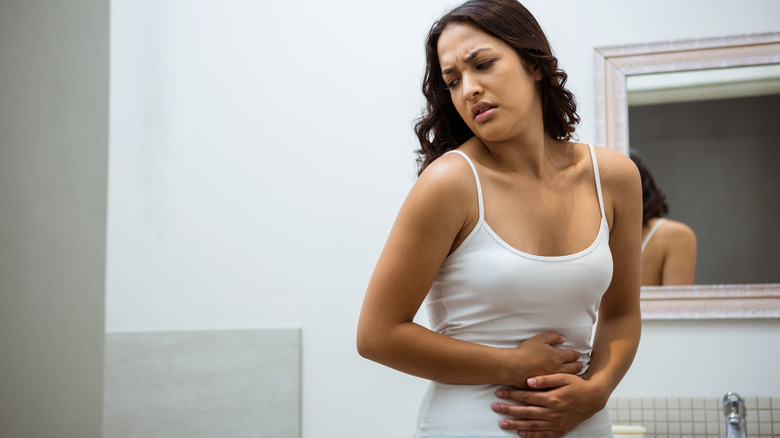Avoid This Common Poop Mistake If You Don't Want Hemorrhoids
Most of us would do anything and everything to avoid the discomfort of hemorrhoids. Sadly, however, approximately 50% of middle age and older adults are affected by these unfortunately-placed, swollen blood vessels, according to the National Institute of Diabetes and Digestive and Kidney Diseases (NIDDK). Some risk factors are out of our control, such as whether or not hemorrhoids run in the family. It's also not uncommon to develop hemorrhoids during pregnancy. Thankfully, there are some modifiable risk factors within our control, one of which is how hard we're pushing during a bowel movement.
Hemorrhoids are swollen veins or blood vessels located around the anal region or inside of the lower rectum that have become irritated due to excess pressure placed upon them. In cases of external hemorrhoids, a person may experience itching, pain, or feel the presence of hard, sore lumps around the anus. Alternatively, individuals with internal hemorrhoids may notice mild bleeding when going number two. Here we'll explain why straining has been associated with the development of hemorrhoids, and what to do if your straining is due to chronic constipation.
Why pushing too hard while pooping may increase the risk of hemorrhoids
Researchers from a 2012 scientific review published in the World Journal of Gastroenterology explain how straining for long periods of time during a bowel movement boosts abdominal pressure. This added pressure placed on the body's rectal veins can restrict blood flow back to the heart, causing the veins to swell. Sometimes alternatively referred to as hemorrhoidal disease, a 2021 research article published in Frontiers in Surgery outlines how previous studies have found a link between straining while pooping and increases in hemorrhoidal disease prevalence rates. Other risk factors identified included constipation and having hard, lumpy stool at least one-quarter of the time.
For some, the discomfort of hemorrhoidal disease may be relatively mild, while for others it may be more severe, such as in cases of prolapse, where internal hemorrhoids painfully bulge out of the anus. In some cases, this may only occur when straining, after which time the veins will retract into the anal canal. In other instances, hemorrhoids may need to be physically pushed back inside of the body — however this is not always possible. To learn more, here's when you should be concerned about hemorrhoids.
What to do if straining is related to constipation
In a 2020 international survey published in the Journal of Comparative Effectiveness Research that included individuals from eight different countries, 11% of respondents reported having hemorrhoidal disease. The vast majority, however, classified their case as "low severity" (71%). Symptom onset most often included bleeding, discomfort, and pain while pooping.
It may be comforting to know that, based on these findings, many people experience more mild cases of hemorrhoids. If this is the case for you, you may be making the common mistake of straining while pooping. If you're pushing with excessive force because you're short on time or simply trying to help things along, try letting up on the pressure the next time you go number two and look into using a squatty potty, which can eliminate the need to strain altogether. Straining, however, is a common symptom for those with chronic constipation, which may require further interventions beyond just easing up on the pushing. "The most important thing is to add fiber to your diet," gastroenterologist Dr. Jacqueline Wolf told Harvard Health Publishing. Although not intended as a long-term treatment method, Dr. Wolf additionally suggests blending 1 tablespoon of mineral oil into your morning applesauce or yogurt to help stool slip and slide its way through the gastrointestinal tract.


